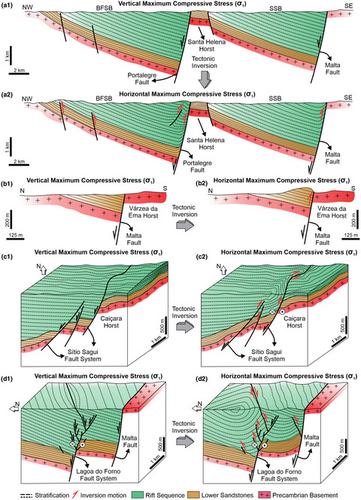当前位置:
X-MOL 学术
›
Basin Res.
›
论文详情
Our official English website, www.x-mol.net, welcomes your
feedback! (Note: you will need to create a separate account there.)
Tectonic inversion assessed by integration of geological and geophysical data: The intracontinental Rio do Peixe Basin, NE Brazil
Basin Research ( IF 2.8 ) Pub Date : 2020-07-10 , DOI: 10.1111/bre.12491 David L. Vasconcelos 1 , Fernando O. Marques 2 , Francisco C. C. Nogueira 1 , Yoe A. R. Perez 3 , Francisco H. R. Bezerra 3 , Rômulo C. Stohler 4 , Jorge A. B. Souza 4
Basin Research ( IF 2.8 ) Pub Date : 2020-07-10 , DOI: 10.1111/bre.12491 David L. Vasconcelos 1 , Fernando O. Marques 2 , Francisco C. C. Nogueira 1 , Yoe A. R. Perez 3 , Francisco H. R. Bezerra 3 , Rômulo C. Stohler 4 , Jorge A. B. Souza 4
Affiliation

|
Common basin models assume that the post‐rift tectonic evolution of most basins is usually associated with tectonic quiescence. However, tectonic inversion during the post‐rift phase has been proposed for several sedimentary basins worldwide, but how and why it happens is still a matter of debate, especially in intracontinental settings where the lithosphere is old and thick. Here, we use geological and geophysical data from the Rio do Peixe Basin in NE Brazil to show evidence that intracontinental sedimentary basins can be tectonically inverted by far‐field compressive stresses acting on pre‐existing weakness zones of lithospheric‐scale where stresses can concentrate and inversion can occur. Geomorphological and field data combined with seismic reflection, gravimetric and borehole data show that: (a) inversion occurred along two main Precambrian lithospheric‐scale shear zones, the Patos (E‐W trending) and Portalegre (NE‐SW trending), which had already been reactivated as basin‐bounding faults during the earlier rift stage; (b) post‐rift reactivation affected (mostly) the original master normal faults with the largest rift displacements, and locally produced new reverse faults; (c) during contraction, deformation was partitioned between fault reactivation and buckling of the incompetent sediment pushed against the hard basement; (d) all these signs of inversion have been observed in the field and can be demonstrated on seismic reflection profiles; and (e) combined gravimetric and seismic data show that the main structures of the basin were followed by an inversion. These data are consistent with the operation of WSW‐ENE horizontal maximum compressive stress as a result of combined pushes of the Mid‐Atlantic Ridge (towards the W) and the Andes (towards the E), responsible for the post‐rift oblique inversion of normal faults inherited from the rift phase and formed with vertical maximum compressive stress.
中文翻译:

通过整合地质和地球物理数据评估的构造反转:巴西东北部里约杜佩谢盆地内陆
普通盆地模型假设大多数盆地的裂谷后构造演化通常与构造静止有关。但是,已经有人提出在裂谷后阶段对全球几个沉积盆地进行构造反转,但是如何以及为什么发生这种反转仍是一个有争议的问题,尤其是在岩石圈古老而厚实的洲际环境中。在这里,我们使用来自巴西东北部里约热内卢佩谢盆地的地质和地球物理数据,显示证据表明,通过作用于岩石圈尺度上已有弱点的远场压缩应力,可以使大陆内沉积盆地发生构造反转。会发生反转。地貌和现场数据结合地震反射,重力和钻孔数据表明:(a)反演发生在两个主要的前寒武纪岩石圈尺度的剪切带上,即Patos(E-W趋势)和Portalegre(NE-SW趋势),它们在较早的裂谷期已作为盆地边界断层重新激活; (b)裂谷后的复活(主要是)影响了裂谷位移最大的原始主正断层,并局部产生了新的逆向断层;(c)在收缩过程中,变形被划分为断层复活和推向坚硬基底的不称职沉积物的屈曲;(d)在野外已经观察到所有这些反转的迹象,并且可以在地震反射剖面上得到证实;(e)结合重力和地震数据表明该盆地的主要结构是反演的。
更新日期:2020-07-10
中文翻译:

通过整合地质和地球物理数据评估的构造反转:巴西东北部里约杜佩谢盆地内陆
普通盆地模型假设大多数盆地的裂谷后构造演化通常与构造静止有关。但是,已经有人提出在裂谷后阶段对全球几个沉积盆地进行构造反转,但是如何以及为什么发生这种反转仍是一个有争议的问题,尤其是在岩石圈古老而厚实的洲际环境中。在这里,我们使用来自巴西东北部里约热内卢佩谢盆地的地质和地球物理数据,显示证据表明,通过作用于岩石圈尺度上已有弱点的远场压缩应力,可以使大陆内沉积盆地发生构造反转。会发生反转。地貌和现场数据结合地震反射,重力和钻孔数据表明:(a)反演发生在两个主要的前寒武纪岩石圈尺度的剪切带上,即Patos(E-W趋势)和Portalegre(NE-SW趋势),它们在较早的裂谷期已作为盆地边界断层重新激活; (b)裂谷后的复活(主要是)影响了裂谷位移最大的原始主正断层,并局部产生了新的逆向断层;(c)在收缩过程中,变形被划分为断层复活和推向坚硬基底的不称职沉积物的屈曲;(d)在野外已经观察到所有这些反转的迹象,并且可以在地震反射剖面上得到证实;(e)结合重力和地震数据表明该盆地的主要结构是反演的。











































 京公网安备 11010802027423号
京公网安备 11010802027423号